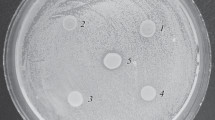Abstract
Plasmid pJP4 encoding the ability to degrade the herbicide 2,4-dichlorophenoxyacetic acid (Tfd+) was transferred by conjugation from Escherichia coli JMP397 to various lithoautotrophic strains of Alcaligenes eutrophus and to the autotrophic bacterium Pseudomonas oxalaticus. The herbicide-degrading function of the plasmid was phenotypically expressed in all of the recipients. The majority of Tfd+ transconjugants also exhibited additional plasmid-encoded properties such as 3-chlorobenzoate degradation, resistance to mercuric ions, and sensitivity to the male-specific bacteriophage PR11. Furthermore, Tfd+ transconjugants were able to act as donors of plasmid pJP4. Physical evidence is presented by agarose gel electrophoresis showing that plasmid pJP4 coexisted with the resident plasmids widely distributed in this group of bacteria. However, in some of the hosts plasmid pJP4 was not stably maintained, had a reduced size and tended to form multimers.
Similar content being viewed by others
References
Aragno M, Schlegel HG (1981) The hydrogen-oxidizing bacteria. In: Starr MP, Stolp H, Trüper HG, Balows A, Schlegel HG (eds) The prokaryotes, a handbook on habitats, isolation, and identification of bacteria. Springer, Berlin Heidelberg New York, pp 865–893
Casse F, Boucher C, Julliot JS, Michel M, Dénarié J (1979) Identification and characterization of large plasmids in Rhizobium meliloti using agarose gel electrophoresis. J Gen Microbiol 113:229–242
Don RH, Pemberton JM (1981) Properties of six pesticide degradation plasmids isolated from Alcaligenes paradoxus and Alcaligenes eutrophus. J Bacteriol 145:681–686
Fisher PR, Appleton J, Pemberton JM (1978) Isolation and characterization of the pesticide-degrading plasmid pJP4 from Alcaligenes paradoxus. J Bacteriol 135:789–804
Friedrich B, Heine E, Finck A, Friedrich CG (1981a) Nickel requirement for active hydrogenase formation in Alcaligenes eutrophus. J Bacteriol 145:1144–1149
Friedrich B, Hogrefe C, Schlegel HG (1981b) Naturally occurring genetic transfer of hydrogen-oxidizing ability between strains of Alcaligenes eutrophus. J Bacteriol 147:198–205
Johnson BF, Stanier RY (1971) Dissimilation of aromatic compounds by Alcaligenes eutrophus. J Bacteriol 107:468–475
Kado CI, Liu St (1981) Rapid procedure for detection and isolation of large and small plasmids. J Bacteriol 145:1365–1373
Mergeay M, Houba C, Gerits J (1978) Extrachromosomal inheritance controlling resistance to cadimium, cobald, copper, and zinc ions: evidence from curing in a Pseudomonas. Arch Internal Physiol Biochim 86:440–441
Meyers JA, Sanchez D, Elwell LP, Falkow S (1976) Simple agarose gel electrophoretic method for the identification and characterization of plasmid deoxyribonucleic acid. J Bacteriol 127:1529–1537
Pemberton JM, Corney B, Don RH (1979) Evolution and speread of pesticide-degrading ability among soil microorganisms. In: Timmis KN, Pühler A (eds) Plasmids of medical, environmental and commercial importance. Elsevier/North-Holland Biomedical Press
Quayle JR, Keech DB (1959) Carbon assimilation by Pseudomonas oxalaticus (OX1). I. Formate and carbon dioxide utilization during growth on formate. Biochem J 72:623–630
Schlegel HG, Kaltwasser H, Gottschalk G (1961) Ein Submersverfahren zur Kultur wasserstoffoxidierender Bakterien: Wachstumsphysiologische Untersuchungen. Arch Mikrobiol 38:209–222
Shapiro JA, Charbit A, Benson S, Caruso M, Laux R, Meyer R, Banuett F (1981) Perspectives for genetic engineering of hydrocarbon oxidizing bacteria. In: Hollaender A, Rabson R, Rogers P, San Pietro A, Valentine R, Wolfe R (eds) Basic life sciences, vol 18. Plenum Press, New York, pp 243–272
Tyler JE, Finn RK (1974) Growth rates of pseudomonad on 2,4-dichlorophenoxyacetic acid and 2,4-dichlorophenol. Appl Microbiol 28:181–184
Author information
Authors and Affiliations
Rights and permissions
About this article
Cite this article
Friedrich, B., Meyer, M. & Schlegel, H.G. Transfer and expression of the herbicide-degrading plasmid pJP4 in aerobic autotrophic bacteria. Arch. Microbiol. 134, 92–97 (1983). https://doi.org/10.1007/BF00407938
Received:
Accepted:
Issue Date:
DOI: https://doi.org/10.1007/BF00407938



